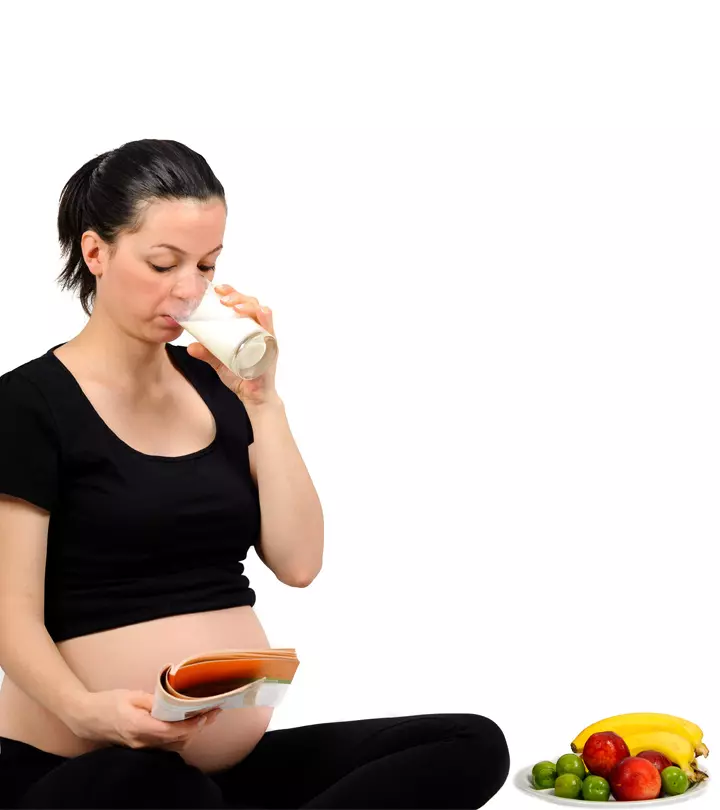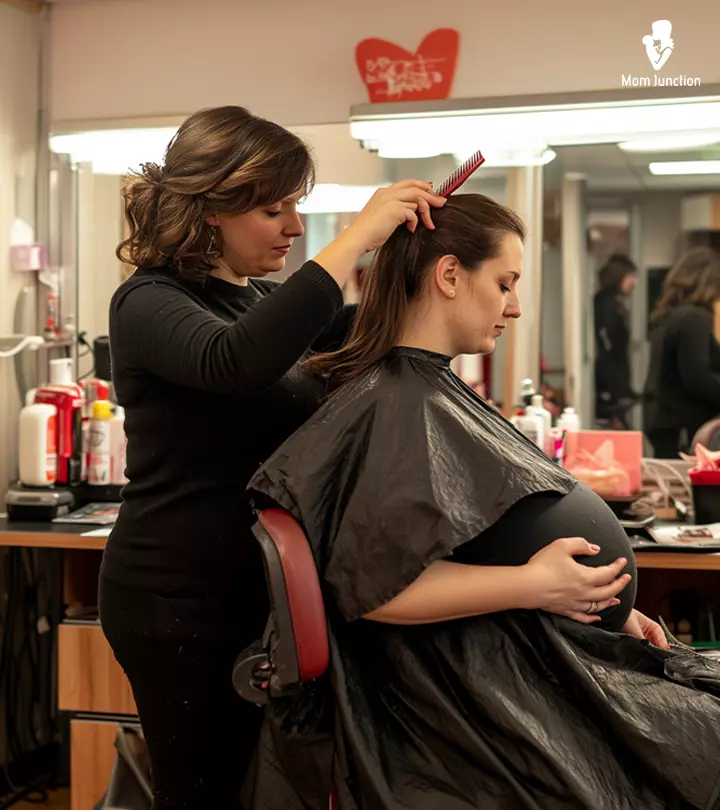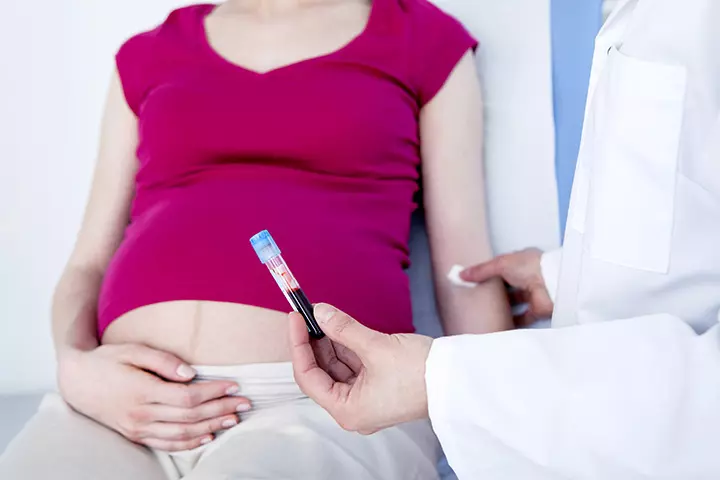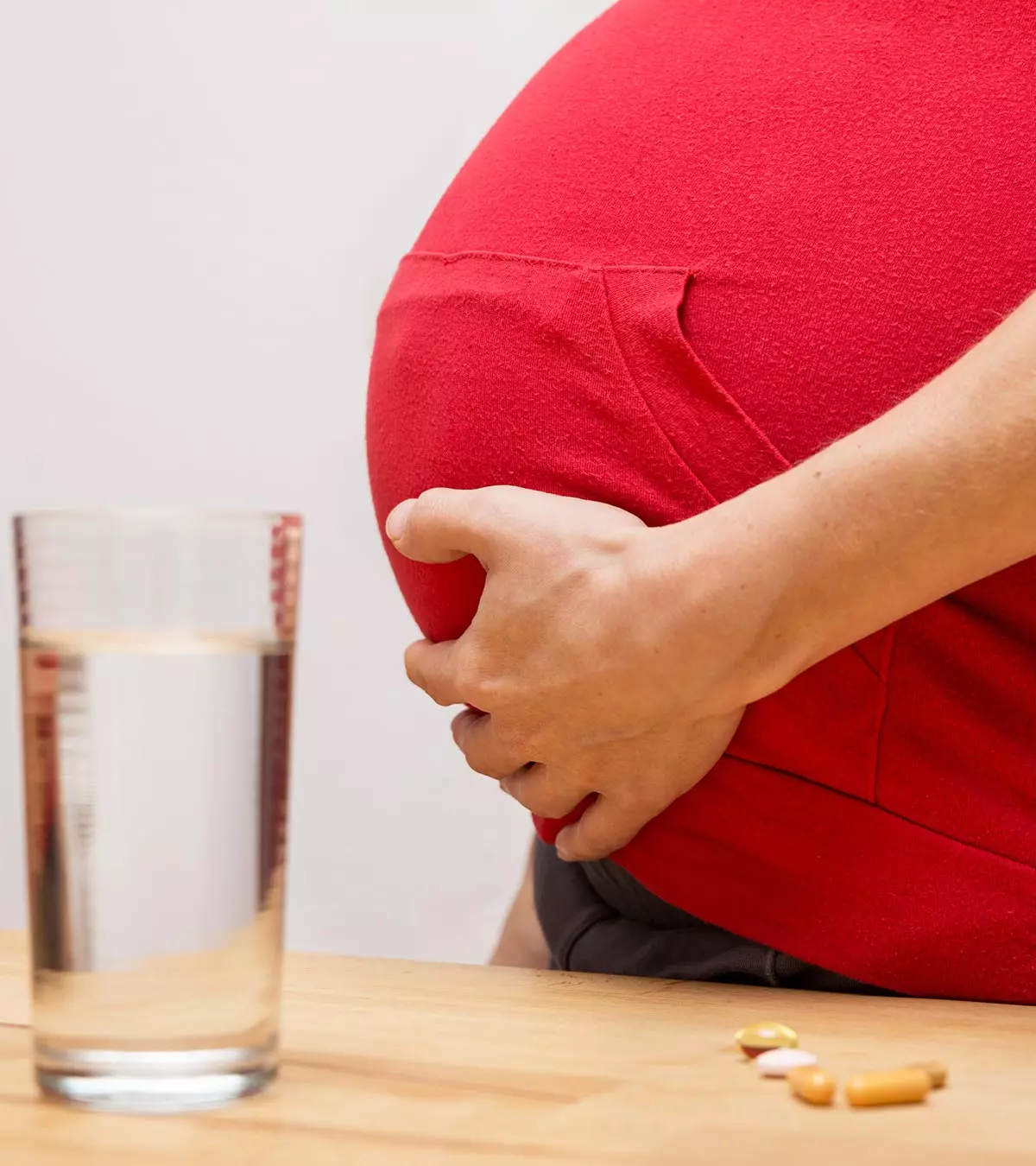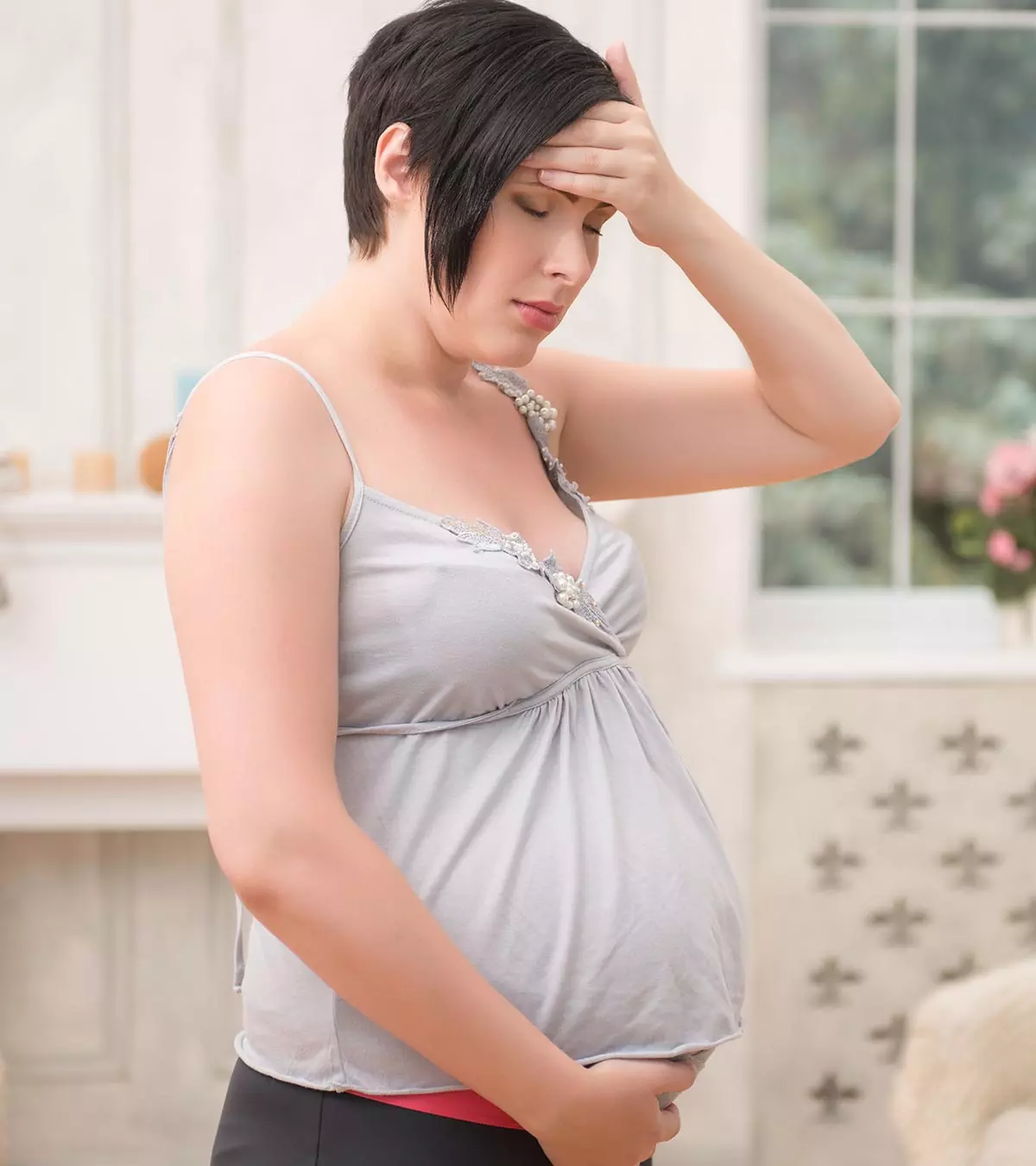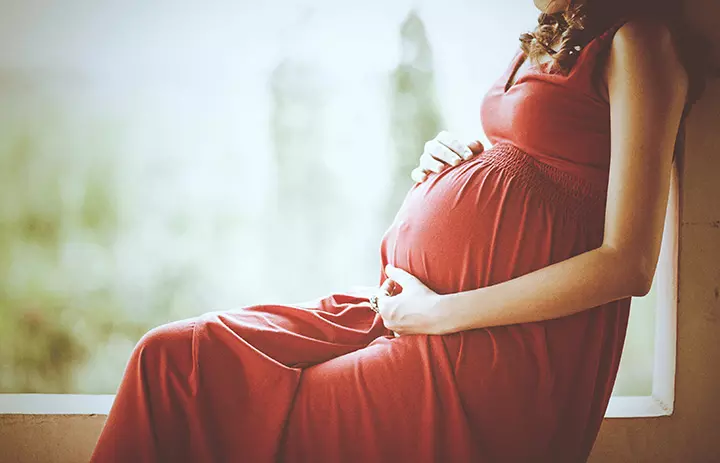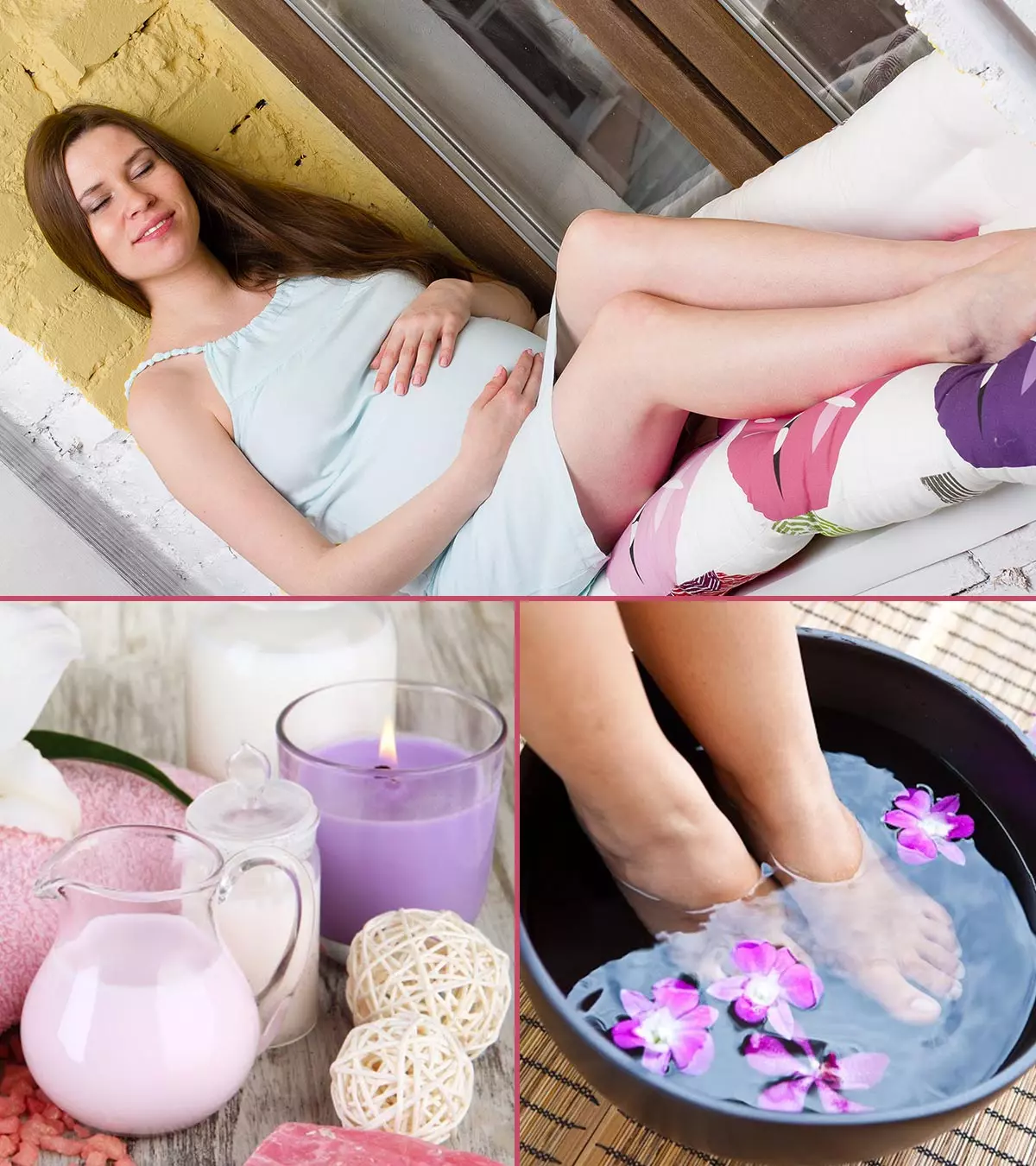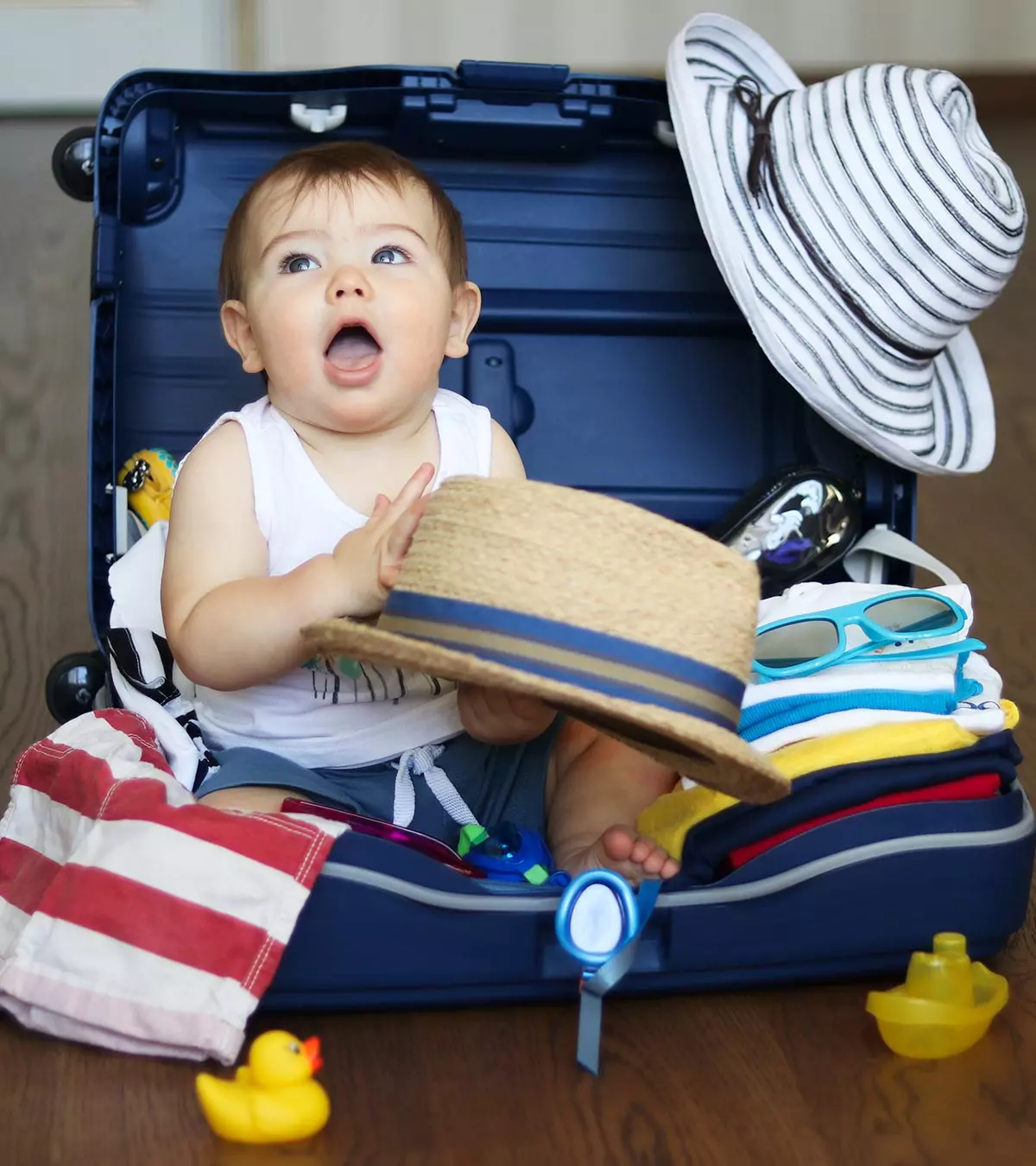
Image: iStock
You don’t have to miss out on adventures after your baby arrives. You simply need the right tips for traveling with a baby to gear up and be prepared.
A fussy baby may be more difficult to handle while traveling. The heavy suitcases and bags full of souvenirs can make it difficult to look after your baby. In addition, when you are traveling with your little one, you may face different difficulties in the various forms of transport. Amidst all these challenges, you need to keep your baby and yourself safe and comfortable.
Keep reading this post, where we have put together some useful tips to make traveling with your baby easy and fun.
Key Pointers
- Traveling with a baby can be stressful, but proper planning and advice can make it joyful.
- Consider your baby’s age, airport and airline regulations, and prepare a checklist for the baby’s essentials when preparing for air travel.
- Adjust the baby’s routine and get a health check-up done before air travel.
- Choose good weather for road travel, use rear-facing car seats for the baby, and have a companion with you.
- Ensure the baby’s safety, pack light, and keep them busy when taking a train journey with a baby.
Preparing For Air Travel With A Baby
Travel by air is highly regulated and requires extensive preparation. Here is what you should know about air travel with a baby.
1. Consider the baby’s age
- The US Federal Aviation Administration, as well as the American Academy of Pediatrics (AAP), states that a baby must be at least seven days old to travel by plane (1). However, it is best to wait until the infant is three months old to minimize the risk of infection.
- Avoid traveling to places more than 8,000 ft (2,438 m) above sea level during the first month of the baby’s life (2). The air around this altitude is thin and can make respiration a bit difficult for an infant.
- As a general rule, avoid traveling when your baby is sick or has just recovered from an illness. Also, get the baby checked by a pediatrician before you travel.
2. Research about the airline and airport
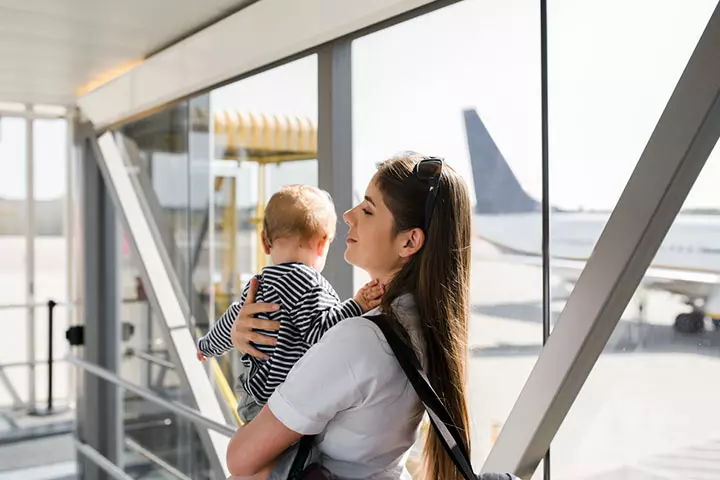
- Always check the policies of the airline before you book the tickets. Every airline has its own set of rules when it comes to traveling with infants.
- Choose airlines that are favorable to parents traveling with an infant. For instance, some airlines offer front seats for parents traveling with babies, to provide maximum leg room and make entering and exiting the plane easier.
- Check if the airline offers an in-flight bassinet or baby carrier. Bassinets can help you and your baby rest well. Also, check if the baby seat you carry is counted as baggage.
- Find out if the aircraft’s toilets have a diaper changing table.
- Learn about the items that you can carry as checked-in luggage. For instance, canned baby food may be restricted, but a pack of infant snacks, such as cereal, may be allowed.
- Expressed formula milk, breast milk, and juice are allowed in the check-in baggage. But find out about whether you can carry formula milk or expressed breast milk in your hand luggage, since you may need these to feed the baby during the flight.
- You will need to buy a ticket even for your infant. However, some airlines offer a discount on it.
- Some airports may offer early check-in, almost several hours before the flight if you are traveling with a baby.
- Also find out about any designated medical facility at the airport, useful in case of emergencies.
3. Preparing the baby
- There’s not much to prepare for when traveling within the country, but when going abroad, you may have to change the baby’s routine.
- The AAP recommends that you adjust your toddler’s sleeping and eating routine according to the time in the country of visit. Do this at least two to three days before your departure (3). It mitigates jet lag and also prevents disruption of the baby’s feeding pattern.
Annie, a mother to an adorable girl, shares her strategy for preparing her baby for an early morning flight. She explains, “I put her to sleep the night before in the onesie I wanted her to wear on the plane (a comfortable, easy-to-open one), this way, I wouldn’t have to change her clothes in the middle of the night, and wake her up more than I had to. All I had to do was feed her, change her diaper, and put her in the car seat, and that’s exactly what I did (i)”
4. The baby travel checklist
- Carry as many diapers as you think your baby will need.
- A plastic bag to store soiled clothes. Carry some ziplock bags too, just in case you are unable to dispose of a soiled diaper immediately.
- Small towels or clothes to wipe the baby’s posseting, which is the tiny amount of food that comes out when he burps.
- A nursing cover so that you can breastfeed anywhere without hesitation.

- Prepared formula within insulated covering to keep it warm. Make the formula just before you leave for the airport. Or, you can make it at the airport if you arrive early.
- Homemade purees for babies older than six months. Carry simple, dry finger foods such as cereals or baked veggies.
- Carry homemade oral rehydration solution for emergencies.
- Nasal bulb and saline solution, in case the baby develops a cold.
- Baby wipes, baby bath products, and diaper cream.
- A first-aid kit. If your baby is on specific medicines, then make sure to carry those. Also, carry medicines like acetaminophen (paracetamol) and ibuprofen after consulting a pediatrician.
- A small blanket, extra clothes, and a pacifier.
- A toy and some books to keep the baby occupied during the flight.
- A foldable baby stroller if needed. Pick one that is compact, easy to carry, and can also pass through the airport X-ray machine conveniently.
- Baby’s passport if you are traveling abroad. If you are flying solo with the baby, then you may have to present a consent letter signed by the other parent. Check with the local rules before your travel.
5. Your travel bags and a baby seat
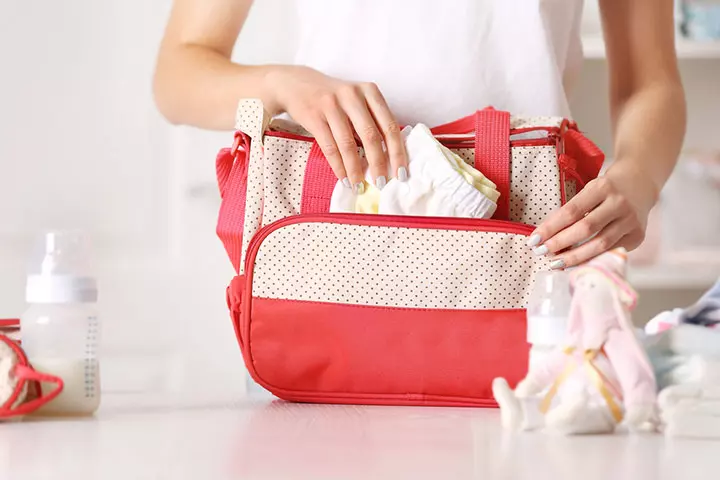
- Carry a separate diaper bag with all the supplies including extra sets of baby clothes you may need during the flight.
- Pack yourself an extra pair of clothing or a t-shirt that fits in your handbag, in case the baby makes a mess and soils your clothes as well.
- According to the Federal Aviation Administration (FAA), infants and toddlers should ideally be held in a child restraint system (CRS), preferably FAA approved, in the aircraft (4).
- The US Federal Aviation Administration (FAA) states that you can carry any CRS car seat that is indicated for use on aircraft and is no wider than 16 inches (4).
- Also, the CRS seats should be installed on the window seat to prevent blocking the path for the other passengers (5).
6. Planning your arrival at the airport
- Reach the airport several hours before the flight to accustom the baby to the crowded airport environment.
- It may take time for an infant to adjust, and you should be free of immediate check-in worries, in case you need to soothe a fussy baby.
- Avoid giving too much water to the baby and cut down on the beverages yourself. It can minimize the number of diaper changes for the baby and loo breaks for you.
If this is your first time traveling by air, it helps to know about the check-in process beforehand.
Check-in And Boarding Of The Flight
Here is what you should know about the check-in and boarding process:
7. Screening the items
- All your baggage, including the car seats, diaper bag, and the formula bottles, will go through the X-ray machine. The food items and medicines that pass through airport security machines are not adversely affected by the X-rays (6).
- During international travel or at some airports, liquid items can be subjected to additional scrutiny, and a sample of the liquid has to be given for testing by the security officers.
- If you do not wish to open a formula or breast milk bottle, then inform the concerned officer. The liquids are then assessed through alternative procedures.
8. Screening you and your baby
- According to the US Transport Security Administration, infants are screened through the metal detector while being held by the parent (7).
- Your baby will not be required to remove shoes for screening.
- Some airports have an advanced imaging technology that uses powerful scanning systems, which infants and toddlers are exempted from.
9. Choosing the right seat
- Choose the front row seats with enough leg space to conveniently strap the CRS seat.
- Choosing the window seat for the baby prevents the CRS seat from impeding the movement of other passengers.
10. Fixing the baby seat
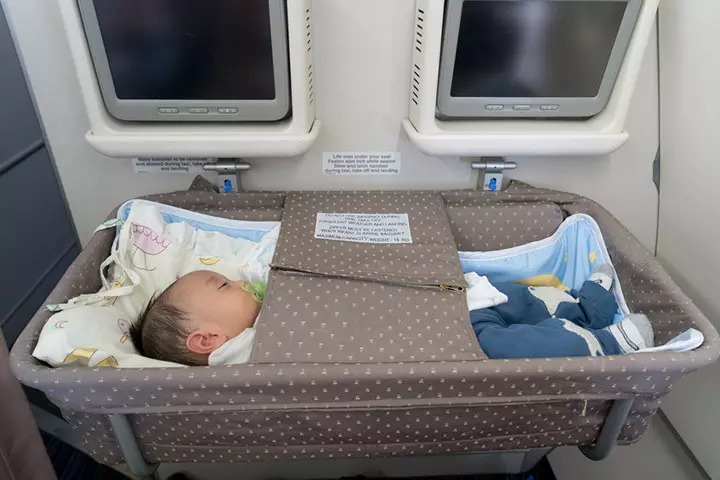
- Learn to attach the CRS seat before your travel. If you need assistance, ask a flight attendant for help.
- After installation, gently nudge the seat to make sure it is securely attached to its place.
- Secure the baby with the straps during the entire duration of the flight.
- If the flight offers bassinet or travel crib, it can be used only when the plane is cruising at a constant altitude and speed.
- Bassinet can be helpful when you are not traveling with an infant seat. In such cases, the baby has to be securely held in the lap by an adult. During cruising speeds, you can place the baby in the bassinet and rest your arms.
11. Preventing crying and keeping baby entertained
- The changes in cabin pressure and the noise inside the aircraft may make the infant fussy and irritable.
- Pediatric experts recommend bottle or breastfeeding and using a pacifier to soothe a crying infant inside a plane (8). Since constant feeding is not ideal, carry a pacifier as suggested by the AAP (9).
- You can consider using small earplugs, specially designed for infants, if the baby seems to be bothered by the engine noise. However, consult a pediatrician before using such earplugs.
- You can consider using a toy or a book to keep the child entertained.
Once you land at your destination, decouple the seat and ensure you do not leave behind any of the baby’s things before deplaning.
During the flight, Annie took measures to ensure her baby remained content and did not cry. She recounts, “Once on the plane, I sat my baby up on my lap and entertained her until it was time for take off. At that point, I began to feed her to help with the pressure on her ears. I had her wrapped up in her favorite blanket, and she fell asleep on my arm for most of the flight. This was amazing.”
 Caution
CautionTips For Traveling By Road With The Baby
Since most safety precautions for road travel and air travel are the same, the checklists for preparation, baby’s luggage, and your luggage remain the same. Other tips for road travel with a baby are discussed next.
12. Use rear-facing car seats initially
- Car seats are the safest way for a child to travel up to the age of four years (10).
- AAP recommends using rear-facing car seats, where the baby faces the back of the car, until the child is two years old (11).
- Check the recommended height and weight by the car seat manufacturer before picking one. Avoid car seats that are too small or too large, even by a few pounds or inches. Always choose a seat approved by a government safety agency.
- A rear-facing car seat should only be placed in the back or second row of the car and not the front where the airbag deployment can catapult the seat forward. A front-facing seat can be placed in the front seat.
13. Plan your trip when the weather is the best
- Plan a road trip with the baby when the weather is likely to be pleasant and the drive smooth and safe. Traveling in hot, sweltering heat can be uncomfortable even with air conditioning, and driving in the rain or snowy conditions can be dangerous.
- If driving during rain, then make sure you pick a route with fewer puddles and more resting stops. If traveling in summer, make sure you carry lots of fluids for your baby.
14. Check for fuel stations on the route
- Fuel stations with a cafe or diner provide enough space for you and your baby to stretch a bit, change the diapers and refresh comfortably.
- It is always good to stop once every hour so that the baby does not feel fatigued.
- You can also check for other essential markers on the road like a doctor’s clinic, pharmacy, and supermarket.
15. Have an adult sitting next to the baby
- It is good to have an adult sit next to the baby when traveling.
- If you are traveling alone with the baby, then use a baby car mirror that is strapped to the headrest of the back seat. The mirror faces the baby in the rear-facing car seat and enables you to see the baby via your car’s rear-view mirror.
- When traveling long distances alone with the infant, you can place colorful images and pictures on the second-row seats to keep the baby occupied (12).
16. Keep baby entertained
- In your car, you are in charge of the entertainment. So play music, nursery rhymes, or anything else your baby enjoys during your trip.
- The adult seated next to the baby can point to exciting sights along the road to keep the little one distracted.
17. Never leave a baby alone in the car
- Always take the baby with you or have an adult in the car if you have to get out of the car for some reason.
- Never leave an infant alone in a car, no matter how quickly you are likely to return.
- The inside of the car can heat up very quickly when the engine is turned off. It can cause the baby’s body to heat up quickly, leading to a heat stroke (13).
- According to the National Safety Council’s injury facts, annually, approximately 38 children under the age of 15 experience fatal heatstrokes due to being left in a vehicle.
 Point to consider
Point to considerTips For Traveling By Train With The Baby
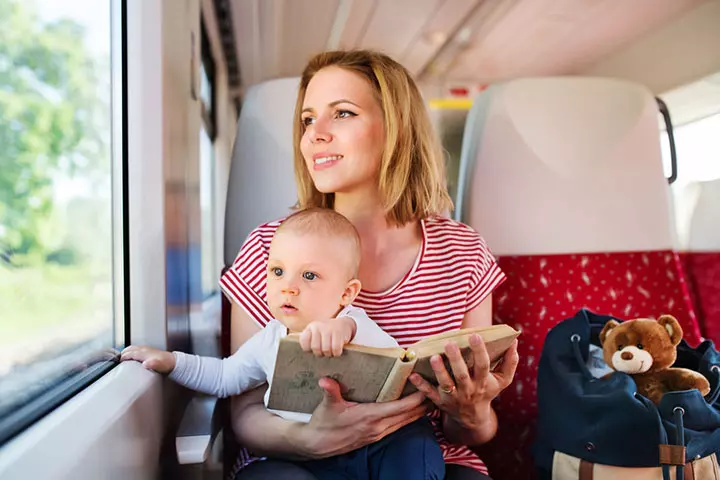
Follow these tips when traveling with the baby on the train.
18. Preferably travel light
- Trains do not offer a lot of luggage space, so carry only the essentials. However, train travel with a baby may be convenient for some as trains do not have a luggage weight limit and you can carry all you need without worrying about the weight or volume.
- If the train has chairs instead of sleeper berths, then you can consider carrying the car seat. However, check with the train operator if the car seat fits on the train seat.
19. Secure the baby properly
- If the car seat cannot be fixed to the train seat, then make sure you securely hold the baby in your lap.
- If you are traveling in a coach with sleeper berths, always place the baby towards the wall of the berth while you sit/lie at the end.
20. Board the train on time
- Arrive at the station on time and board the train without delay.
- You have a small window to board the train, so focus on getting into the train safely with the baby, while leaving the luggage for your partner or a porter to handle.
- Even if you are a bit delayed, avoid rushing when trying to board the train with a baby.
21. Keep the baby busy
- The moving sights outside the window are quite likely to make the baby drowsy and asleep.
- You can use books or toys that can distract the baby or keep it calm throughout the journey.
22. Be prepared minutes before your destination
Have your luggage ready in one place before getting off the train. It prevents last moment confusion and rush that can be unsafe when you have a baby in hand.
23. Keep baby within line of sight
- Trains are more crowded than a plane or a car. Make sure you always have the infant within sight.
- Always have your partner or an adult traveling with you watch the baby when you go to the washroom or the pantry.
- You need to be extra careful in case of toddlers who have started to walk and tend to wander away inconspicuously.
 Quick tip
Quick tipFrequently Asked Questions
1. How long should I wait before traveling with a baby?
You can travel with your baby as small as seven days old. But, avoid taking them to crowded places until they are three months old as they do not have enough immunity and may be more prone to contracting infections (12).
2. Do babies’ ears hurt when flying?
The pressure difference between the outer and middle ear may cause discomfort during the ascent after the take off and descent before landing (8).
3. Is it safe to travel with a newborn by car?
Yes, you may travel with your infant by car, provided you follow all car safety measures such as using an approved rear-facing car seat, riding with the baby in the back seat, taking frequent breaks, and carrying all essentials with you (14).
4. What is the most difficult age to travel with a baby?
Depending on the age, traveling with a baby can have different challenges. For instance, traveling with a newborn can be difficult, especially for longer, as the baby is immobile and needs frequent feedings. On the other hand, as the baby grows up and becomes mobile, they require more attention and care. Also, they may have disrupted sleep patterns and are prone to meltdowns, making traveling difficult.
5. How long may a baby be strapped into a car seat?
Car seat manufacturers recommend that a baby should not remain in a car seat for more than two hours in 24 hours as it could strain their developing spine (16).
6. Can I feed my baby during takeoff?
Experts recommend mothers feed babies during takeoff to help protect the baby’s ear from the pain that may occur due to cabin pressure changes (15).
Traveling with a baby, especially for new parents, could be stressful, and you may avoid it unless essential. Some useful tips for traveling with a baby include preparing a baby kit, traveling with a spouse or another adult companion, finding the right seat, and having extra diapers and feeds. It is also essential to feed the baby on time and keep them entertained during the journey. Following these suggestions and making timely preparations and plans may make your travel with a baby easy and stress-free.
Infographic: Essentials To Carry When Traveling With A Baby
Traveling with a baby can be challenging, especially if you’re new parents. However, proper planning can make the journey with the baby enjoyable and hassle-free. The following infographic includes travel essentials parents should have on the journey.

Illustration: Momjunction Design Team
Illustration: Tips For Travelling With A Baby
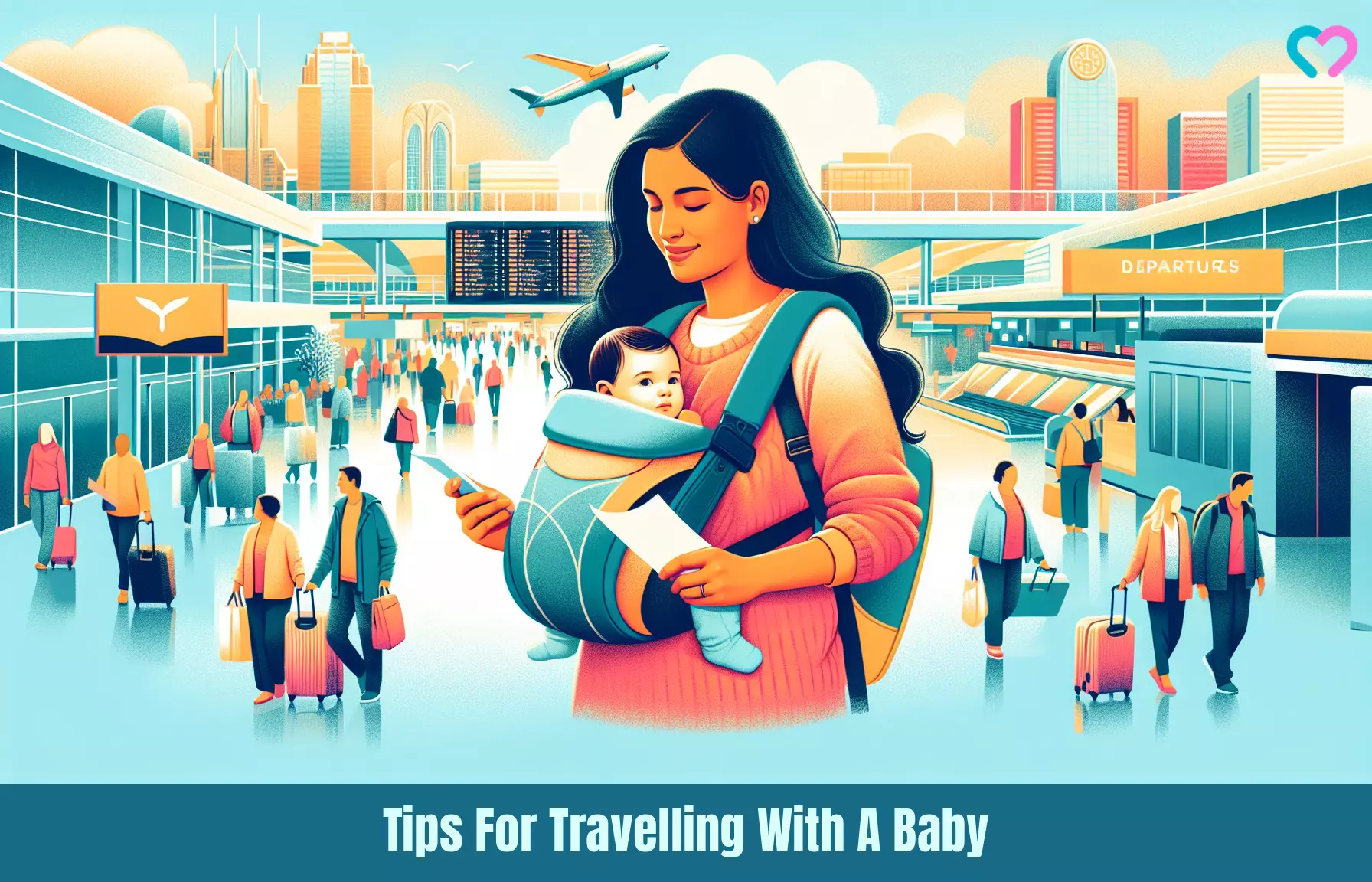
Image: Dall·E/MomJunction Design Team
Personal Experience: Source
MomJunction articles include first-hand experiences to provide you with better insights through real-life narratives. Here are the sources of personal accounts referenced in this article.
i. Traveling with baby…tips, tricks, and my experience.https://themommytruths.wordpress.com/2015/10/12/travelling-with-baby-tips-tricks-and-my-experience/
References
- Flying with a baby: feeding, sleep and your other questions answered, NCT.
https://www.nct.org.uk/information/baby-toddler/caring-for-your-baby-or-toddler/flying-baby-feeding-sleep-and-your-other-questions-answered - Newborn – Flying and mountain travel, PediaClinic.
https://publications.aap.org/patiented/article-abstract/doi/10.1542/ppe_schmitt_173/82244/Newborn-Flying-and-Mountain-Travel - Travel safety Tips, Healthy Children.
https://www.healthychildren.org/English/safety-prevention/on-the-go/Pages/Travel-Safety-Tips.aspx - Flying with Children, Federal Aviation Administration (FAA).
https://www.faa.gov/travelers/fly_children#:~:text - Child Safety Tips, FAA.
https://www.faa.gov/travelers/fly_children#:~:text=The%20safest%20place%20for%20your,pediatric%20injuries%20on%20an%20airplane. - Frequently Asked Questions on Cabinet X-ray systems, FDA.
https://www.fda.gov/radiation-emitting-products/security-systems/frequently-asked-questions-cabinet-x-ray-systems - Traveling with Children, TSA.
https://www.tsa.gov/travel/tsa-cares/traveling-children - Flying with baby: Parent FAQs, Healthy Children.
https://www.healthychildren.org/English/safety-prevention/on-the-go/Pages/Flying-with-Baby.aspx - Pacifiers: Satisfying your baby’s needs, Healthy Children.
https://www.healthychildren.org/English/ages-stages/baby/crying-colic/Pages/Pacifiers-Satisfying-Your-Babys-Needs.aspx - Forward-facing car seats for toddlers and pre-schoolers, Healthy Children.
https://www.healthychildren.org/English/safety-prevention/on-the-go/Pages/Forward-Facing-Car-Seats-for-Toddlers-Preschoolers.aspx - Rear-facing car seats for infants and toddlers, Healthy Children.
https://www.healthychildren.org/English/safety-prevention/on-the-go/Pages/Rear-Facing-Car-Seats-for-Infants-Toddlers.aspx - Traveling with a newborn: by car or train, Winchester Hospital.
https://winchesterhospital.org/health-library/article?id=598939 - Prevent child deaths in hot cars, Healthy Children.
https://www.healthychildren.org/English/safety-prevention/on-the-go/Pages/Prevent-Child-Deaths-in-Hot-Cars.aspx - Is it safe for my baby to travel in a car seat a few hours at a time?
https://www.healthychildren.org/English/tips-tools/ask-the-pediatrician/Pages/Is-it-safe-for-my-baby-to-travel-in-a-car-seat-a-few-hours-at-a-time.aspx - Travel Recommendations for Nursing Families
https://www.cdc.gov/infant-toddler-nutrition/breastfeeding/travel-recommendations.html - Health risk aspects and comfort of infants in infant seats for cars
https://www.diva-portal.org/smash/get/diva2:670258/FULLTEXT01.pdf
Community Experiences
Join the conversation and become a part of our nurturing community! Share your stories, experiences, and insights to connect with fellow parents.
Read full bio of Dr. Richard Mario Lurshay
Read full bio of Rohit Garoo
Read full bio of Dr. Ritika Shah
Read full bio of Vidya Tadapatri





